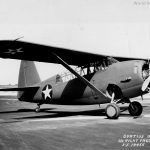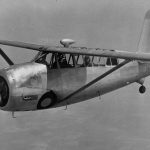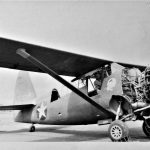O-52
O-52 Owl
“Owl” on the ground
O-52
Owl in flight
Owl 40-2883
O-52 40-2883
O-52 40-2736
O-52 40-2691
O-52 1941
O-52 1941 2
O-52 1941
Owl from 119th Squadron New Jersey Air National Guard
O-52 100 10AB
O-52 rear
History
The Design Bureau of Curtiss Aeroplane developed the Model 85 design in 1940. The new short-range observer was to continue the long line of similar aircraft that succeeded each other in the ranks of American military aviation for about twenty years. Its direct predecessor was the North American O-47A, which entered service in 1937. The designers focused on takeoff and landing characteristics, maneuverability, reliability and low cost of construction. They opted for a high-plane design, previously proven on the XF12C-1 and XF13C-1 experimental carrier-based fighters. It provided excellent visibility for both crew members, the pilot and the observer, seated in a large closed cockpit. The result was a light and compact airplane of somewhat peculiar appearance – a short barrel-shaped fuselage and a long straight wing, reinforced by struts going to the fuselage. To achieve good takeoff and landing characteristics, the wing was equipped with leading-edge slots and trailing-edge flaps. Its mechanization scheme included ailerons of hanging type: when the flaps were opened to the maximum angle, both ailerons also went down and deflected by 15°. Both flaps were hydraulically actuated.
The general layout of the undercarriage was borrowed from the fighter BF2C-1, but the wheels were no longer operated by a manual winch, but by a hydraulic actuator. The wheels were stowed in special niches on the sides behind the engine. The narrow landing gear track was certainly a disadvantage for an airplane that was to operate on primitive filed airfields. But the upper position of the wing avoided the danger of catching on the ground during possible swinging. The tail wheel was not retractable. A Pratt & Whitney R-1340-51 Wasp radial engine with 600 hp takeoff power, driving a Hamilton Standard three-blade automatic propeller, was chosen for the new scout. The fuel load (408 liters) was in two unprotected tanks in the root compartments of the consoles. The comparatively small plane was well equipped with instruments, a landing light, radio, intercom and even a radio compass. A camera and two parachute flares were also provided for night flights. In an emergency, the pilot would drop the entrance door and the gunner would leave his seat by opening the canopy.
The O-52 was lighter than all similar machines in service with the European Air Forces – British Westland Lysander or German Henshel Hs 126B. The low weight was due in part to the abandonment of the secondary role of direct support aircraft. The O-52, unlike other short-range reconnaissance aircraft, could not carry a bomb load. Its armament was limited to two .30 Browning machine guns. One of them, a synchronous machine gun, was fixed at the front (with 200 rounds), and the second one, with 500 rounds, was mounted on a bolt carrier behind the gunner’s seat. The plane had no armor protection.
The USAAF ordered a series of 203 O-52s before the first prototype took off in 1941. The “Owl” turned out to be maneuverable, pleasant to fly, and quite fast. The combination of low weight and good aerodynamics meant that the O-52 with its 600 hp engine was as fast as the O-47A with its 975 hp engine. It was not able to operate in conditions of strong air defense and a large concentration of enemy fighters in the air. Slow and poorly armed “all-purpose” biplanes and monoplanes began to be replaced by high-speed machines, usually converted from fighters. US Army decided that long-range reconnaissance could best be handled by twin-engine bombers. Once outfitted with cameras, such machines could fly higher, faster, and farther than the plodding Owl. For shortterm tactical reconnaissance, the new liaison class of aircraft such as the Piper Grasshopper was desirable based on economy, ease of maintenance,
and ability to fly from improvised airfields. A few 0-52s were sent overseas prior to the attack on Pearl Harbor and presumably saw action; the remainder served in training roles in the United States.
Serials
Serial numbers: 40-2688 – 40-2890
Source
Peter M. Bowers: Curtiss aircraft, 1907-1947
John C. Fredriksen: Warbirds An Illustrated Guide to U.S. Military Aircraft 1915-2000














